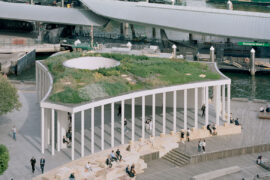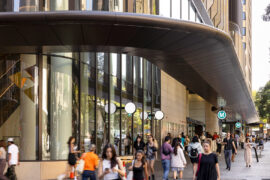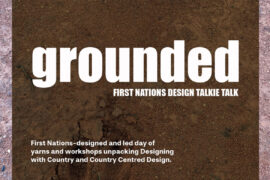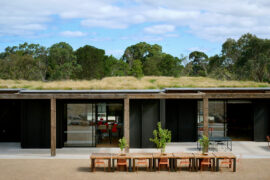In this comment piece, Lindy Johnson, director of Lindy Johnson Creative, urges architecture to communicate its value. Johnson says that architects are needed more than ever but their value is highly underrated — and that we’re all the poorer for it.

Architect Kim Baber with architecture and design advocates Lindy Johnson and Martyna Kulczyk, photograph by Emma Nevison.
May 8th, 2023
A common misconception about architects held by the general public is that they only design expensive houses. This is sometimes true — but it is far from the profession’s only job. So, how can the real value of architecture be communicated? And why is this important? Architects have the skills to address key challenges of the present and the future. Climate change, the housing crisis, and the demands on our expanding cities need ambitious architectural thinking.
Designing for climate change
Climate change is causing increasingly regular, extreme, and costly weather events — and the built environment is being severely affected. Who can forget images of, for example, the town of Lismore being submerged by 2022 floods? The population needs building design that will withstand the full impact of climate change.
Architects, alongside their colleagues in engineering and urban planning, are in the best position to design for floods, fires, and extreme heat. Reducing carbon emissions is another challenge facing the profession. The construction sector is responsible for 39% of global emissions, and construction is one of Australia’s most active industries.

Architects are well-placed to advise the sector on cost and material efficient carbon-cutting measures such as changing supply chain processes and adaptive reuse practices. When it comes to sustainability and the built environment, architects are leading the way.
Our industry knows this—but there is still a lack of understanding in the wider public. As such, communicating architects’ knowledge of climate-resilient design is crucial. More understanding will lead to more resources and more informed decision-making.
Addressing the housing crisis
As we all know, housing stress is fast increasing in Australia (the Australian Bureau of Statistics defines “housing stress” as when a household pays more than 30% of their gross income on housing costs). Key contributing factors include population growth and lack of public and private investment in quality, affordable housing.
A 2022 study by the UNSW City Futures Research Centre estimated that 640,000 Australian households are currently experiencing housing stress. This figure is projected to rise to almost one million by 2041.

These statistics have a serious human cost: young families, older single women, and low-income Australians are unable to find reasonably priced homes, especially in capital cities. And the challenge is not just getting into a home — it’s finding a well-designed one. Residential design fundamentally impacts the cost and quality of everyday life.
Architects can help address the housing crisis by designing affordable homes with good access to amenities: green space, natural light, and natural ventilation. As the population grows, the need for quality medium-density dwellings will also continue to rise. For Australians used to the suburban dream of the stand-alone house, this requires an adjustment in thinking that needs to be reflected in thoughtful design.
Architects are skilled at balancing the need for individual privacy with access to community. This is essential — loneliness kills people. The profession needs to stand up and advocate for its expertise in designing superior medium-density housing.
Related: SJB and the question of housing density

Contributing to civic life
I see architects’ value as unsurpassed when they are creating vibrant public infrastructure with future-proofed value. After all, architects are the kingpins of designing for human behaviour. For example, consider how they can contribute to quality public design in the upcoming Brisbane Olympics.
A skilled practice will consider everything from outdoor precincts, where athletes and visitors can walk from venue to venue, right through to the specification of the doorknobs on well-ventilated stadium toilets. Without architects’ big picture perspective combined with attention to detail, there is a risk the Brisbane Olympics infrastructure won’t serve Queenslanders long-term.

One way to embed strategic design thinking into high impact decision-making is in the role of the government architect, who traditionally acts as a design advisor for policymakers. Given the importance of architecture socially and economically, it is insane that governments aren’t investing in architects. Instead, government architect offices are, on the whole, under-resourced and lacking in authority.
The Victorian state government halved the role’s funding in 2022. Despite recent advocacy from the Australian Institute of Architects and Architecture Media, there is no Australian federal government architect. Part of the problem is a lack of understanding in the community about what architects bring to the table — and some blame lies with architects.
Architects need to do more to articulate their value
The profession has not done enough to communicate the true value of good design. Architects have so much knowledge and expertise to share with the Australian people. I want to hear their voices on the importance of design to our built environment and every aspect of our lives. At the moment, I’m not hearing them.
As the effects of climate change are increasingly felt and Australian cities and regional hubs continue to grow, skilled designers will play an essential role in society.
Every hospital, school, and sports facility needs good architecture. Effective design communication means that the broader public can understand the immense contributions architects make to society every day.
Lindy Johnson Creative
lindyjohnson.com.au
Photography
Various

We think you might also like this editorial on AI in architecture and design.
INDESIGN is on instagram
Follow @indesignlive
A searchable and comprehensive guide for specifying leading products and their suppliers
Keep up to date with the latest and greatest from our industry BFF's!

London-based design duo Raw Edges have joined forces with Established & Sons and Tongue & Groove to introduce Wall to Wall – a hand-stained, “living collection” that transforms parquet flooring into a canvas of colour, pattern, and possibility.

Pier Pavilion by Besley & Spresser provides a refreshing, architecturally thoughtful and versatile public space by the water at Barangaroo.

With Steelcase having reopened its refreshed WorkLife Showroom in Singapore this year, we spoke to Navedita Shergill about some key workplace macro shifts identified in their research.
The internet never sleeps! Here's the stuff you might have missed

‘Civic Vision | Foster + Partners’ is the first comprehensive exhibition of the practice’s work to be held in Australia, providing an in-depth look at its global portfolio of work since it was founded in 1967 by Norman Foster.

The New York headquarters of haircare brand, Amika, has been designed by Civilian as the antithesis of a standard business hub.

Several design groups are coming together on 29th October, 2025 for ‘grounded,’ a day of talks and workshops on Country-centred design.

McIldowie Partners, in association with Joost Bakker, has been awarded The Learning Space at the INDE.Awards 2025. Their project, Woodleigh Regenerative Futures Studio, redefines the educational environment as a living ecosystem that nurtures sustainability, innovation, and community.